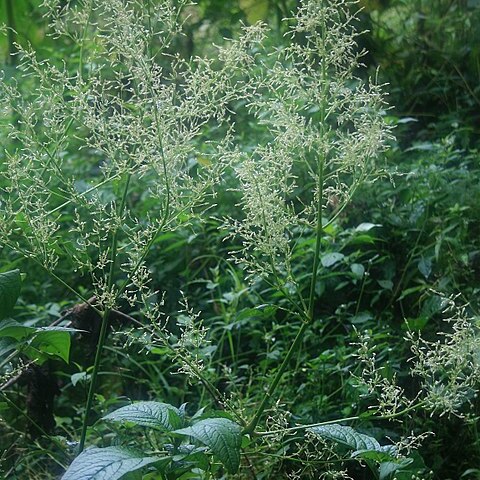Flowers perfect, polygamous or dioecious, bracteate and bibracteolate, subsessile in spikes or glomes. Sepals 5, discrete, hypogynous, concave, subequal, becoming scariose, often with conspicuous tufts of hairs between the sepals and the bracteoles. Stamens 5, the filaments flattened and united below into an entire or appendiculate tube; anthers bilocellate, oblong, introrse, medially attached. Ovary I-locular, 1-ovulate; ovule campylotropous on an elongate flattened funicle; stigmata 2-3, filiform or deltoid. Fruit an indehiscent utricle; seeds cochleate-orbiculate, whitish or reddish brown, smooth. Glabrous to copiously pubescent herbs, shrubs, trees or clambering vines. Leaves opposite, entire to denticulate, petiolate, glabrous to sericeous, herbaceous to coriaceous. Inflorescences of spikes or glomes, paniculately disposed, the branching alternate, opposite or verticillate.
Herbs, shrubs or vines, annual or perennial, polygamous or dioecious. Stems erect to prostrate, often trailing. Leaves opposite or alternate, petiolate; blade elliptic, ovate, or lanceolate to lance-oblong, margins entire or serrulate, glabrous or pubescent. Inflorescences terminal, diffuse, open panicles of spikes and axillary spikes; bracts and bracteoles membranous. Flowers unisexual; tepals 5, basally connate or distinct, 1-3-veined; stamens mostly 5; filaments connate basally; anthers 2-locular; pseudostaminodes absent or short; ovule 1; style 1, ca. 0.2 mm; stigmas 2-3, slender or capitate. Utricles globose, membranous, dehiscing irregularly. Seeds 1, dark red or reddish-brown, lenticular. x = 15.
Annual or perennial herbs, shrubs or subshrubs, sometimes scandent, rarely small trees, with opposite leaves and branches. Leaves simple, entire or ± incised. Flowers androgynous, polygamous or dioecious, bibracteolate, inflorescence frequently paniculate. Perianth-segments 5, free, frequently pilose or lanate. Stamens 5, shortly monadelphous at the base; pseudostaminodes occasionally well developed, more commonly short or obsolete; anthers unilocular. Ovary with a single pendulous ovule; stigmas 2 3, elongate, or sometimes capitate in functionally ♂ flowers. Capsule membranous, indehiscent. Embryo annular, endosperm present.
Erect or scrambling herbs to subshrubs; nodes tending to be flattened, encircled by a line of longer hairs. Leaves opposite, petiolate, often more or less pubescent. Inflorescence of axillary and terminal panicles of spikes; bracts and bracteoles present, persistent. Flowers minute, sessile, bisexual, or unisexual and dioecious; tepals 5, in female flowers with a tuft of short and straight, or long and tangled, hairs from base, in male flowers not hairy at base; stamens 5, filaments united below to form a cup, anthers 2-locular, pseudostaminodia present or not; ovule 1, stigmas 2(-3), subsessile.
Herbs erect or climbing subshrubs. Leaves opposite, margin entire or serrate. Flowers perfect or unisexual on different plants, very small, solitary or clustered in spikes and again arranged into complex thyrsoid structures. Bracts and bracteoles often shiny, membranous. Tepals 5, membranous, long hairy or nearly glabrous, base not rigid. Stamens 5; pseudostaminodes very small or absent in female flowers. Ovary compressed; style very short or absent; stigmas 2, rarely 3, subulate; ovule 1, pendulous. Utricles globose, compressed, indehiscent. Seeds shiny, lenticular or reniform.
Fls perfect or unisexual, the plants then variously polygamous to monoecious to dioecious; cal deeply 5-parted; stamens 5; filaments connate at base; anthers bisporangiate and unilocular; ovary compressed; style very short; stigmas usually filiform; ovule 1; utricle compressed, membranous, indehiscent; herbs or shrubs with opposite, petiolate lvs and small or minute fls in spikes or aggregated into panicles. 70, irregular.

